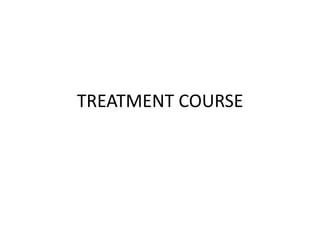
Ect treatment course
- 3. ECT procedures carry some risk • Risks are associated with the induction of general anesthesia, the seizure and convulsion, the interaction between concomitant medications and ECT, and other aspects of the ECT procedure • The most common side effects involve cognitive changes, transient cardiovascular alterations, and general somatic complaints.
- 4. Contraindications • According to the American Psychiatric Association (2001), ECT has no absolute contraindications. However, some conditions pose a relatively high risk.
- 5. Medical conditions associated with increased risk from ECT • Space-occupying intracerebral lesion (tumor, hematoma, etc.) • Other condition causing increased intracranial pressure • Recent myocardial infarction • Recent intracerebral hemorrhage • Unstable vascular aneurysm or malformation • Pheochromocytoma • High anesthesia risk (American Society of Anesthesiologists [ASA] class 4 or 5) Source. American Psychiatric Association 2001.
- 6. Mortality Rate • Despite what can be perceived as the invasive nature of ECT, the overall mortality rate from ECT in a general population of patients is extremely low, estimated at 2–10 per 100,000 patients (0.0001%) (Shiwach et al. 2001). This is roughly the same ratio as for the induction of brief general anesthesia itself. • Some data suggest that patients who receive ECT have a lower mortality rate due to nonpsychiatric causes of death than do patients with psychiatric illness who do not receive ECT (Munk-Olsen et al. 2007).
- 7. Cognitive Changes The clinician should keep in mind a couple of facts about cognitive changes: • First, depressive episodes themselves are often accompanied by profound cognitive changes, which are sometimes severe enough to present as dementia (pseudodementia). In such cases, a successful response to ECT may actually be associated with at least a subjective improvement in cognitive status. • Second, cognitive change is not equivalent to structural brain damage.
- 8. Three types of cognitive impairment may be observed with ECT • Postictal disorientation • Interictal confusion • Amnesia (anterograde and retrograde memory disturbances).
- 10. Cardiovascular Complications • Cardiovascular complications are the main cause of mortality and serious morbidity with ECT, although most such complications are minor (Weiner and Coffey 1993; Zielinski et al. 1996) • During the seizure and acute postictal period, both the sympathetic and parasympathetic autonomic systems are sequentially stimulated. • Activation of the sympathetic system increases heart rate, blood pressure, and myocardial oxygen consumption, placing an increased demand on the cardiovascular system
- 11. Other Adverse Effects • Headaches, generalized muscle soreness, and jaw pain are the most common side effects, usually lasting up to several hours, but occasionally longer
- 12. Managing the ECT Seizure • Missed Seizures when no motor and ictal evidence of seizure activity is seen following the electrical stimulus
- 13. Causes Insufficient stimulus intensity Premature termination of stimulus Poor electrode contact with the skin Patient’s high intrinsic seizure threshold Hypercarbia due to hypoventilation
- 14. Inadequate Seizures • Seizures of “inadequate” duration
- 16. Seizure Augmentation • Evidence suggests that missed or inadequate seizures occurring at maximum stimulus intensity decrease the likelihood that the patient will respond to treatment. • When these phenomena occur, efforts should be directed at: Decreasing the seizure threshold Increasing the seizure duration or both (Krystal et al. 2000).
- 17. Seizure Augmentation Presently, four methods of seizure enhancement are commonly used: • Decreasing the anesthetic dosage (if possible and if the agent used has anticonvulsant properties) • Hyperventilation (inducing hypocarbia) • Caffeine (and other adenosine receptor antagonists) • Ketamin anesthesia (Weiner et al. 1991).
- 18. Prolonged seizure Seizure activity lasting longer than 3 minutes (American Psychiatric Association 2001).
- 19. :Causes 1) At the first treatment 2) During benzodiazepine withdrawal 3) In patients in whom proconvulsant medications (e.g., caffeine, theophylline) and lithium 4) In patients who have epilepsy or preexisting paroxysmal EEG activity
- 21. Index ECT • In addition to making the decisions of ECT, the practitioner must also make a determination of: How frequently the seizures should be induced (i.e., the interval between treatments) How many treatments should be administered in the treatment course.
- 22. Frequency of Treatments Most ECT treatments are given three times a week whereas in other countries they may be administered twice weekly. Increased frequency is associated with a more rapid response, it may also be associated with increased cognitive side effects A three-times-weekly schedule appears to be an acceptable
- 23. Number of Treatments • A total number of treatments averaging between six and twelve but no exact number • The number of treatments will vary according to the individual and severity of medical condition.
- 24. Maintenance ECT After the conclusion of a course of ECT, three options are available for continued treatment: 1. Administration of applicable psychotropic medications (e.g., antidepressant, antimanic, and/or antipsychotic agent) 2. Administration of continuation ECT 3. Psychotherapy combined with either medication or continuation ECT.
- 25. • A fourth option, involving the use of both continuation medication and ECT, may be necessary for patients with a history of failure of prophylaxis with either treatment alone.
- 26. Maintenance ECT Multiple psychiatric disorders respond to maintenance ECT including: major depressive disorder psychotic depression bipolar disorder and schizoaffective disorder (Birkenhager et al. 2005).
- 27. • Use of maintenance ECT in the geriatric population is also well documented (Thienhaus et al. 1990).
- 28. • Particular forms of schizophrenia (catatonia, refractory positive symptoms) may also be responsive to the combination of ECT and antipsychotic medication (Shimizu et al. 2007; Suzuki et al. 2006)
- 30. • A typical arrangement would involve weekly ECT for 4 weeks, then incremental increases in the interval between ECT treatments to once a month over the next few months (Clarke et al. 1989).
